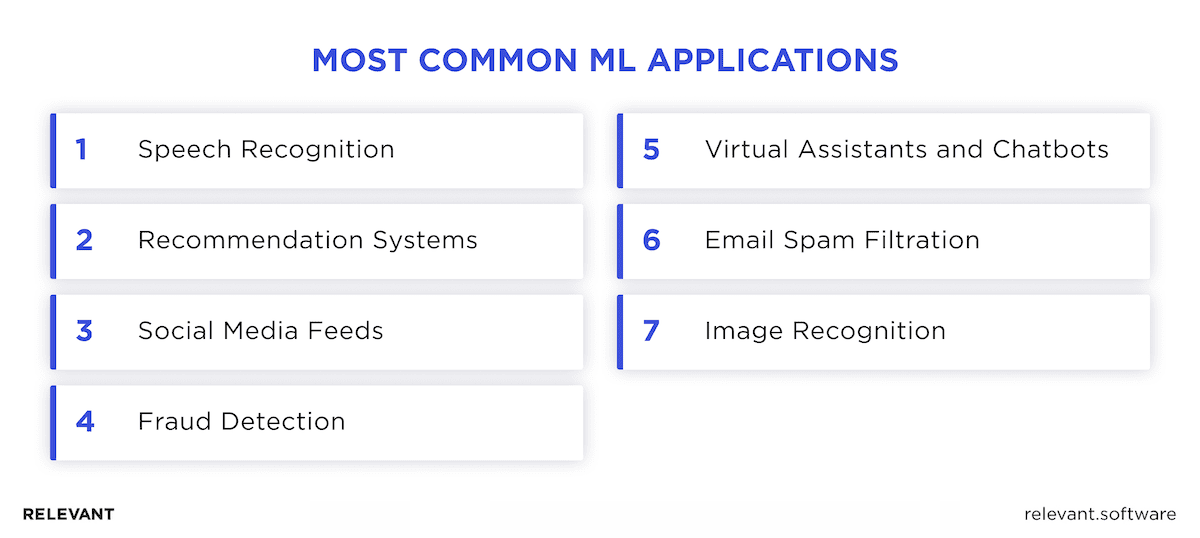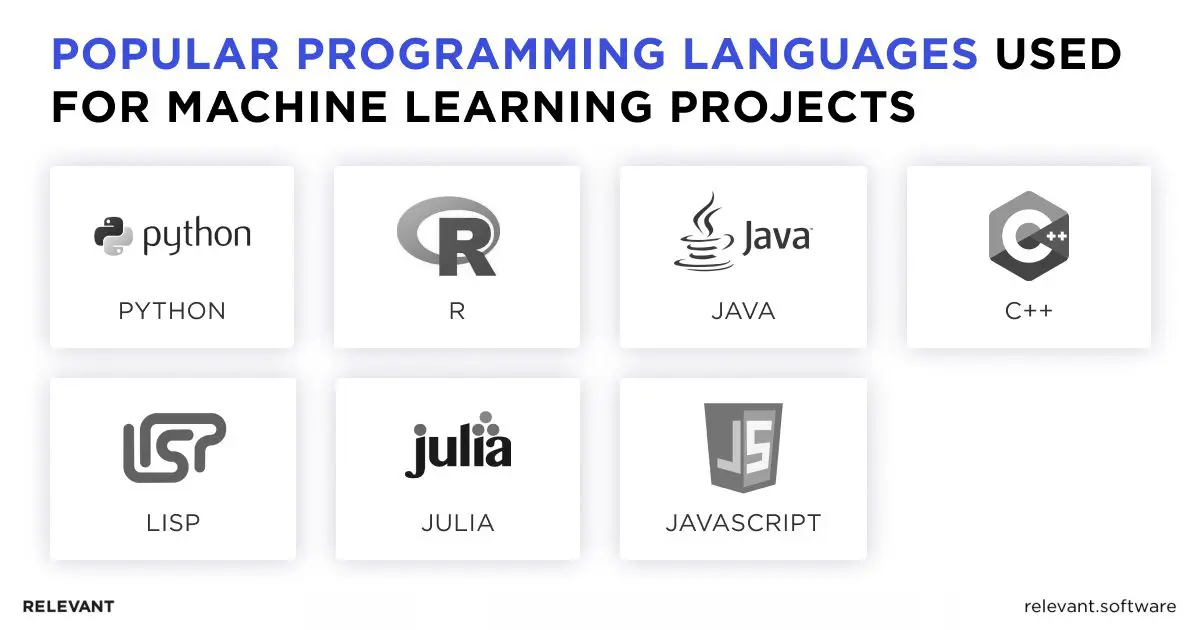Secure Your Project Success with the Best Language for Machine Learning

Even though numerous companies already today heavily rely on AI, for many entrepreneurs and project managers, machine learning is still a powerful yet enigmatic force. Indeed, machine learning development is complex and demands skillful management of a lot of things (strategic vision, technical complexities, resource allocation, etc.). While the strategic vision is individual for each company, the tech aspect is more or less universal and the one we can help with. One of the critical technically-related choices you’ll need to make is to select the best language for machine learning.
Many of our clients who opted for AI development services faced a similar challenge: what is the best language for a machine learning project and, most importantly, how to make the right decision. That’s why we decided to discuss the most popular language choices among our machine learning engineers and tell more about how to pick a technology for your project needs.
What is Machine Learning?
With all the buzz around machine learning, let’s cut through the noise and get a clear picture of what it truly is.
Machine learning, or just short ML, is one of the branches within a broader term of AI, which trains computers to learn from data and make predictions. To put it bluntly, ML is a set of mathematical algorithms. Yet, unlike the standard program that follows a predefined set of rules, the ML system doesn’t need programming in the traditional sense. Instead, it uses data to train itself on how to perform tasks. ML-based tools develop the ability to recognize patterns that might indicate certain tendencies and make decisions based on them with minimal to no human intervention.
ML algorithms can be found in countless situations and applied for various purposes.

Criteria for Choosing a Machine Learning Language
So, how can one select the best programming language for machine learning? Since there are many good options to choose from, you need some points of orientation to guide your choice. Here are the key criteria that will help you narrow down your options.
- Performance and Speed
Machine learning software development often involves the process of massive datasets and complex computations. A language with high performance and speed ensures faster training times, quicker model deployment, and smoother real-time applications. This is especially crucial for projects that deal with real-time predictions.
- Library and Framework Support
Extensive libraries and frameworks pre-built for ML tasks offer a significant advantage. They offer ready-made functionalities for data manipulation, model training, deployment, and other tasks involved in ML development that save engineers time and effort. A set of supportive tools that simplify standard tasks lets developers spend more time on the specific problem at hand rather than reinvent the wheel for common tasks.
- Community and Documentation
When a language has a strong and active community, it benefits machine learning app development in several ways. Developers can find quicker solutions to problems through forums and other dedicated resources. Plus, languages with large communities have extensive documentation, guides, and tutorials, which help anyone master the language faster and improve their knowledge with time.
- Ease of Use
For projects that require rapid prototyping or where team members have limited machine learning skills and experience, a language with a gentle learning curve is advantageous. This allows developers to pick up the language quickly and go ahead with model creation faster. A clear and concise syntax further contributes to faster development and easier maintenance of the codebase.
These criteria will help you choose the best programming language for AI and machine learning-driven applications that optimize development efficiency and empower your team to create robust AI systems.
Top 7 Languages for Machine Learning
When you have to select the best programming language for machine learning among the dozens of options, it’s understandably difficult. For those business leaders new to ML technology, it may also be tough to identify the most in-demand languages and know about their particularities. While the specific needs of your project will dictate the ultimate choice, the review of these top languages will give you a better idea of where to start your searches for the best languages for machine learning and AI.

Python
Python is among the top languages developers have chosen to work with lately due to its simplicity and versatility. Because of its clear and concise syntax, along with an intuitive structure, Python is also one of the easiest languages to learn, as well as great for fast prototyping. As a high-level language similar to JavaScript, Python may not run as quickly as some other languages. However, the tremendous selection of libraries for any application you might need (data analytics, special effects, AI, ML, and more) compensates for it.
Why is Python the best language for machine learning?
Python’s popularity as one of the top languages for ML is closely linked to the fact that it has always been used for less enterprise-focused and more scientific fields like sentiment analysis and data science. Because of that, the language offers thousands of code libraries, many of which were built specifically for ML-driven applications. For instance, TensorFlow allows both beginners and experts to train algorithms with minimal coding. It saves hours of developers’ time if they would need to write the code from scratch.

An additional feature that speaks in favor of Python is that it uses much less code than any other OOP language. That’s a benefit when we speak about ML development, which inherently employs a lot of algorithms with less code; it lets you implement even the most complex logic.
Here’s a breakdown of some key aspects of Python that solidify its position as the most suitable language for ML projects:
- Paradigm: Object-oriented and imperative
- ML frameworks: TensorFlow, PyTorch, scikit-learn, Keras
- IDEs best for ML: PyCharm, Jupyter Notebook, Visual Studio Code
R
With over two million users and 15,000 packages available, R is quite an adaptable and powerful tool for anyone who needs to deal with statistical analysis and data visualization. What’s more, you don’t have to be an expert programmer to use R; even those with basic knowledge can leverage it effectively for data analytics or data mining.
Why is R the best language for machine learning?
The popularity of R among statisticians partly accounts for its widespread use in the ML community. While R often plays a supplementary role alongside other languages, it’s far from a sidekick. It shines in its own right for tasks like sentiment analysis and is the go-to tool for scientific fields like bioinformatics and bioengineering.
Yet, this language would be ideal for any data-heavy ML projects. Most R packages are specifically designed to simplify the complexities of data-intensive tasks. To name a few, the caret is for streamlined model training, nnet is for neural networks, and randomForest is for ensemble methods that improve prediction accuracy.
Key R features for ML projects:
- Paradigm: Purely functional.
- ML frameworks: caret, Rpart, nnet, data.table, randomForest.
- IDEs best for ML: RStudio and Jupyter Notebook for interactive analysis.
Java
Considered an all-around specialist in programming languages, Java is extremely popular among developers. Java’s object-oriented nature simplifies code organization and reuse, while its versatility allows code written once to run on any platform with a compatible Java virtual machine. It’s reliable and applicable to the development of large-scale enterprise systems, web pages, and Android apps.
Why is Java the best language for machine learning?
Java’s high scalability makes it ideal for large and complex ML projects. Thanks to the Java Virtual Machine, it’s possible to swiftly develop and deploy ML tools. Java’s fast execution due to its compiled nature also benefits AI and ML development, where you have to deal with massive datasets and complex models. Similar to other languages we mentioned, Java provides a decent selection of libraries. Deeplearning4j, in particular, offers comprehensive support for deep learning, Weka delivers algorithms for data collection tasks, and MOA supports real-time analytics.

Probably, Java’s biggest strength is its compatibility with popular big data frameworks (Hadoop, Apache, Spark, etc.), so it seamlessly integrates with technologies many organizations already use. In other words, if you choose Java for ML projects, you can easily integrate it with your current code repositories, which will save you time and money. This is why major tech companies like Twitter, LinkedIn, and Facebook rely on Java for big data management.
Key Java features for ML projects:
- Paradigm: Primarily object-oriented, with elements of imperative and structured programming.
- ML frameworks: Deeplearning4j, Weka, MOA.
- IDEs best for ML: Eclipse, IntelliJ IDEA, and NetBeans.
C++
C++ is classified as a mid-level language, which is a sweat spot between low-level (Assembly) languages that communicate closer to the machine’s native code and high-level (Python or JavaScript) languages that mimic human language logic. C++ incorporates features from both: it allows direct hardware manipulation similar to low-level languages, and at the same time, it offers high-level functionalities like object-oriented programming that simplify coding and increase abstraction. To be specific, C++ executes faster (its low-level part) and is easier to manage and develop complex systems (its high-level features).
Why is C++ the best language for machine learning?
Well, C++ lets developers better and more precisely manage memory resources and tune algorithms. Due to these capabilities, C++ is well suited for AI applications that require fast analysis of large datasets. Even so, the language is not the best choice for quick prototyping, data analysts and ML engineers prefer C++ for its ability to build high-performance, production-ready ML systems.
Since C++ offers strong control over system performance, it’s extremely popular for robotics, mobile IoT apps, augmented and virtual reality projects that need high responsiveness. By the way, the use of ML in these areas grows exponentially, so the selection of C++ language can provide you with dual benefits. Finally, you can take advantage of the various ML libraries that will speed up and simplify development. Some good ones Relevant ML engineers use are the Caffe framework for deep learning; the DyNet library for neural networks, and the Shogun library, which offers a diverse array of models. C++ API for TensorFlow is another obvious benefit of this language.
Key C++ features for ML Projects:
- Paradigm: Primarily object-oriented.
- ML frameworks: Dlib, Shark, TensorFlow (C++ API).
- IDEs best for ML: Visual Studio, Code::Blocks, and CLion for robust development environments.
Julia
Julia was born out of a desire to brush aside the need to choose between speed and ease of use. It’s engineered to handle high-performance numerical and computational work as swiftly as C and maintain the simplicity of Python. Julia is a general-purpose language frequently used to build performance-critical applications for aerospace and biotechnology.
Julia’s unique strengths lie in its:
- Speed: Julia’s just-in-time (JIT) compilation allows for near-native performance that exceeds even C++ in certain tasks.
- Ease of use: Julia’s syntax is rather readable and approachable compared to other languages like C++, for example, which makes it easier to learn and maintain code.
- Scientific focus: Julia’s built-in support for scientific computing and numerical operations makes it a natural fit for data-intensive ML projects.
Why is Julia the best language for machine learning?
Although Julia is a fairly young language, its popularity among the ML community is growing really fast. Computational science and numerical analysis are the two areas where Julia truly shines. What makes it an even more attractive option for ML applications is scalability, as it allows developers to deploy apps rapidly at large clusters. And certainly, it possesses robust ML frameworks that can accelerate development. Check out Flux.jl for neural networks and TensorFlow.jl, which make use of Julia’s strengths to perform faster and more efficiently in large-scale deployments and complex tasks. As a result, less time spent on code and algorithm optimization, while faster development and deployment times.

Key Julia features for ML Projects:
- Paradigm: Multi-paradigm (procedural, functional, and object-oriented).
- ML Frameworks: Flux.jl, MLJ.jl, and TensorFlow.jl.
- IDEs for ML: Juno and Jupyter Notebook.
LISP
LISP is the second-oldest language that remains in use today. Well, it’s not exactly one language but a family of languages that include branches like Common Lisp, Scheme, and Racket. All of them share the core principles of functional programming and symbolic expressions that were invented specifically for LISP.
Why is Lisp the best language for machine learning?
It isn’t the most popular language, but thanks to its symbolic reasoning and its ability to manipulate code as data, it’s quite an in-demand language for ML development. If you eagerly look for easily readable code and flexibility, LISP is a good choice to consider. It can interpret code from more than 30 languages and can adapt to the solution you have already started to develop. But the true value of LISP for AI projects is its symbolic expressions, which are critical for natural language processing tasks.
Key Lisp features for ML projects:
- Paradigm: Multi-paradigm (procedural, functional, and symbolic).
- ML frameworks: cl-ml, mgl, and others that support neural networks and statistical learning.
- IDEs for ML: Emacs (Slime), a favorite among Lisp programmers used to debug and develop interactive apps.
JavaScript
Arguably, the world’s most prevalent language, JavaScript (JS), is a high-level language that powers the internet alongside CSS, PHP, and HTML. Who knew the language originally designed for simple macros would become so deeply rooted in web development? Today, JS usage for web development is as ubiquitous as oxygen in the air we breathe – it’s simply everywhere, and there’s no way to avoid it.
Why is JavaScript the best language for machine learning?
JavaScript, the undisputed king of the web, has also unexpectedly found its way into the ML development field. Not every ML model operates on servers; many need to run right in a web browser. Developers often direct the output from the ML models into interactive web dashboards, and that’s the territory of JavaScript that works best with browsers.
The toolkit of JavaScript in ML also grows. Today, you can make use of the math.js library that accelerates the JS capacity for heavy computations. Then, JS accommodates the well-known TensorFlow.js ML package (adapted from Python), which allows you to use, retrain, and build new ML models right in the browser. Some other useful libraries include Synaptic for neural network simulations and OpenCV.js for image processing.
Key JavaScript features for ML projects:
- Paradigm: Event-driven.
- ML Frameworks: TensorFlow.js, Synaptic, OpenCV.js, math.js.
- IDEs for ML: Visual Studio Code and WebStorm.
So, what is the best programming language for machine learning? Our project delivery manager would say: “There’s no “best” or one-size-fits-all language for ML development. It all depends on your project’s goals and your team’s experience. Ultimately, the best language is the one that lets you solve your problem in the most efficient and productive way.”
Related: Choosing the Right Language for AI: What’s Hot, What’s Not
Factors to Consider When Choosing a Language
It can be difficult to select the best language for machine learning and AI even from this short list, not to mention the dozens of options available. Let’s review some factors that can help you make a decision.
Project Requirements
If you deal with huge sets of data, a high-performance language like C++ could be your best bet for its speed and power. For real-time data processing needs, compiled languages like Java would be a good choice. Or, if you are looking for data analysis and visualization, then Python or R might be a smart decision due to their extensive libraries. In the end, the key is to know your project goals – you need to create prototypes fast or process data rapidly – to choose the best programming language for machine learning that supports your ML project requirements.
Team Expertise
Just like any good race team, your ML project will benefit from leveraging your crew’s strengths. If your team is fluent in Python, choose a familiar language like that because it will streamline development and boost efficiency. While there might be a “theoretically” better language out there, a comfortable and experienced team that uses their preferred tools can often outperform a team that has to work with a new language.
Future Scalability and Maintenance
Think long-term! Before you even start to develop your ML project now, you should consider its future journey. Will it need to handle datasets that would increase exponentially? Will it be integrated with other systems down the line? In this regard, a language with a strong community and established libraries can scale smoother and make maintenance simpler. Languages like Python, with its enormous number of tools and frameworks, might be a wise choice for projects with an eye on the future.
Best Language for Machine Learning: Bottomline
So, you’ve wrestled with the age-old question: what is best programming language for AI and machine learning? The truth is, there’s no champion. The best language for your project is the one that suits your needs the most.
Yet, the language is just one piece of the puzzle in complex ML software development. The road gets bumpy when you need to handle unruly data, choose the ML algorithm, and then tune it for peak performance unless you hire AI engineers. Our team of experts can help you:
- Clean and structure your data to prepare it for accurate analysis
- Choose the right ML models, languages, and tools that align with your project’s goals.
- Adjust parameters and algorithms to maximize performance.
- Build scalable and efficient architectures that grow with your needs.
- Integrate models into production and provide continuous support for updates and improvements.
Avoid the complexities of ML app development and concentrate on your vision and the big picture while our AI specialists handle the intricate details. If you have any questions or would like to get expert consultation on your project, just contact us.



